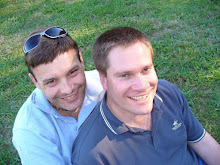
I’ve spent less than 24 hours in Portland until now. Several years ago I briefly stopped here on a
business trip while Garry flew on to Dallas, Texas where we had planned a vacation. As a result, I saw
very little of Portland, or its popular landmarks. I recall the river and its many bridged but little else.
Garry and I decided to base ourselves here
for two nights as part of our West Coast road trip.
Originally it was simply a convenient midpoint between Crater Lake and Seattle. However, we discovered there's plenty to admire about the city and its scenic location.
We arrived late on Friday after driving solidly for more than five hours
from Crater Lake. Our route took us north
through the city of Bend and on past an elegant, snow-capped Mount Hood. Our arrival at Mount Hood coincided with the region's annual Cascade to Coast fun run. Relay teams compete to run a route from Mount Hood to the Pacific Coast over a 12-hour period.
As we drove towards Portland we found ourselves constantly passing runners, their supporters and race attendants along the highway. I must confess that Mount Hood proved a rather disappointing location. While the mountain is rather stunning, the township isn't. At one point I had considered stopping here overnight rather than continuing on to Portland. I'm glad we didn't.

On Saturday morning we drove into to town to soak up the atmosphere
of the weekend market held along the banks of the Willamette River. The markets get a prominent write up in every
tourist reference. Sadly, we found the market
rather small and lacking character.
Ironically, we were more fascinated by the queue snaking out of Voodoo
Doughnuts, another of the city’s iconic landmarks. Voodoo sells all manner of sweet and savoury
products including Maple Bacon favoured doughnuts. We decided to give the queue a miss.


Instead we wandered through the old town and into the heart
of downtown. We discovered Macy’s
Department Store was having a special one day sale. Clothing already marked down up to 60% was
being marked down an additional 25% if you agreed to donate $5 to a local
charity. It took very little maths to
work out how much money we could save.
Needless to say both of us ended up spending hours at Macys buying an
entire Summer wardrobe for a pittance.
For example, I grabbed a smart pair of Lacoste dress shorts for $11,
marked down from an original retail price of $70


With much of our sightseeing time consumed by shopping we
decided to make our last stop of the day a little special. We drove to Vista House located 30 miles out
of town on a bluff overlooking the spectacular Columbia Gorge. It was built in 1917 on one of the most
beautiful scenic points on the original Columbia River Highway (a highway long
since superseded by a non-descript interstate freeway). The drive was worth every minute as the view
was simply stunning.
Our final day in Portland actually saw us drive south out of
town to McMinnville, home to the Evergreen Aviation & Space Museum. I begged Garry to add this destination to our
itinerary after learning that the infamous Spruce Goose was displayed
here. This aircraft, completed in 1947 under
the personal instruction of Howard Hughes, is the largest ever built from
wood. At the time of its completion it
was by far the world’s largest plane.
The Spruce Goose was decades ahead of its time. This reality is brought into stark contrast
by a small Douglas DC3 that sits under one of its wings. At the time of its completion most commercial
air passengers were still flying in these tiny aircraft. It would be another 20 years before anything
of a similar scale was built; that is, the Boeing 747. It truly is an enormous aircraft.
The museum proved to be a pleasant surprise. The complex consists of three spacious,
light-filled, elegantly designed buildings.
Each contains cleverly designed exhibits that offer just the right level
of detail to keep the most jaded visitor enthralled. Even Garry had to admit that it was better
than he’d expected. This is high praise
considering the number of similar venues I’ve reluctantly dragged him into over
the years.
I was also excited to discover the original X-38 test
vehicle on display. This was originally
developed as an emergency lifeboat for the International Space Station. However, the entire project was cancelled in
2002 when space station construction over-runs gutted NASA’s annual budget. Sadly, the 80% scale model on display was the
only craft ever built. It was used to
test the X-38’s aero-dynamic characteristics.





















































